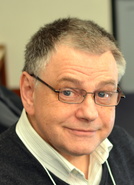No preliminary knowledge of advanced mathematics is required. MAT 150 serves as an alternative to MAT 200 for students in the Advanced Track.
Prerequisites
- Score of level 4 or better on the math placement exam,
- or MAT 123 passed with a grade C or better,
- or a permission by the instructor.
Priority given to students in the University's honors programs.
Notice that the prerequisites do not include any Calculus. High-school
algebra suffices.
Though the course is not easy: as any mathematics, it relies on proofs.
Lecturer
 Oleg Viro
Oleg ViroProfessor, Ph.D. 1974, Doctor Phys-Mat.Sci. 1983, both from Leningrad State University
Arrived at Stony Brook in 2007.
Office: Math Tower 5-110
Phone: (631) 632-8286
Email: oleg.viro AT math.stonybrook.edu
Web page: www.math.stonybrook.edu/~oleg
Research fields: Topology and Geometry,
especially low-dimensional topology
and real algebraic geometry.
Program of the course
1. Sets. Basic notions of set theory: set and its elements, empty set, subset. Operations on subsets: intersection, union, difference and complement. Set-theoretical identities.
Definition and properties of the Cartesian product of sets. Definition and properties of a power set.
Maps: the domain, codomain, and range of a map; the image and preimage of a set; the graph of a map. Special maps: identity, constant, inclusion. Submaps and restrictions of a map. Projection map and quotient map. Definition and properties of characteristic function of a set.
Definition an properties of a composition of maps. Injection, surjection and bijection. Definition and properties of inverse map. Equivalence of invertibility and bijectivity. Basic examples of functions and their inverse: exponential and logarithmic, tangent and arctangent, etc.
Binary relations in a set. Properties of a binary relation: transitivity, reflexivity, irreflexivity, symmetry, antisymmetry. Strict and non-strict partial orders. Linear orders. Equivalence relations and partitions of a set. Equivalence classes and the quotient set. Examples of equivalence relations from modular arithmetics. Projection map of a set to its quotient set. Quotient maps and the factorization of a map.
2. Predicates. Predicates and subsets. Algebra of predicates and algebra of subsets. Propositional forms. Logical connectives (negation, conjunction, disjunction, implication, and equivalence). Truth tables. Attaching emotions to logical connectives (logical conjunction vs. colloquial and, but, though, nevertheless, etc.). Disjunctive and conjunctive normalizations of a propositional form.
Conditional and biconditional sentences, different linguistic expressions associated with conditionals and biconditionals (sufficient, necessary, sufficient and necessary, whenever, if and only if, iff etc. Difference between implication in mathematics and causation in language/everyday life.
Logical identities and how to prove them. Tautology and contradiction, de Morgan's laws, the law of excluded middle and the law of consistency. Constructing of useful denials of propositional forms. The contrapositive, the converse, and the inverse of a conditional statement.
3. Quantifiers. Quantifiers and various linguistic expressions associated with them. Translating propositions formulated in a colloquial English into symbolic forms and the other way around. Analyzing and constructing propositions involving several quantifiers. Free and dummy variables.
When quantifiers commute and when they don't. Constructing useful denials of propositional forms and quantified sentences.
Logical structure of a definition. Mathematical definitions as biconditional sentences with a single free variable. An agreement about conditional colloquial expressions in definitions. Logical structure of a mathematical theorem. Absense of free variables in a statement of a theorem.
4. Proofs. Structure of a mathematical theory: basic objects, propositions: axioms and theorems. The role of proofs. Distinguishing the formulation (statement) of a theorem and its proof and the difference between motivation and proof.
Examples and counterexamples. When and why examples prove. Types of proofs: direct proof, proof by contraposition, proof by contradiction, proof by exhaustion.
Typical logical mistakes, like affirming the consequent or denying the antecedent. Principle of mathematical induction in various forms (induction, strong induction, well-ordering principle).
5. Cardinality. Equipotent sets and cardinality of a set. Examples of equipotent sets: $\mathbb N$ and $\mathbb Z$; $\mathbb R$ and $(0, 1)$. Addition and multiplication of cardinal numbers. Properties of operations: commutativity, associativity, distributivity. Cardinal numbers of the empty set and a singleton.Definition and elementary properties of finite sets. Pigeon hole principle, its reformulations and corollaries. Natural numbers as cardinalities of finite sets. Counting principles for finite sets (addition, multiplication, inclusion-exclusion).
Notions of denumerable, countable and uncountable sets. Basic facts about arithmetics of denumerable sets. Cantor's theorem about uncountability of $\mathbb R$. Continuum hypothesis.
Cantor's theorem about inequality between the cardinalities of a set and its power set. Inequality for cardinal numbers. Linearity of the ordering of cardinal numbers, Cantor-Schroeder-Bernstein theorem.
The part of the course devoted to excurcions to mathematics is not fixed beforehand. Some of the excursions appear as illustrations to the language part. Some fill the breaks between its chapters. For an idea about the topics, see the web page of MAT 150 of Spring 2016.
Lectures time and location
Office hours
Tuesdays 11:30am - 12:30pm in Math Tower P-143.
Grading policy
- Homeworks 10%,
- Quizes 20%,
- Midterm 30%,
- Final exam 40%.
In MAT 150, the main purpose of homeworks is to keep students aware about the material of lectures: definitions, examples, statements of theorems, some proofs. More creative challenging problems (e.g., compose a problem or generalize a theory given in a lecture) will be proposed, but rarely and only as non-compulsory bonus problems.
The exams, both midterm and final will serve the same purpose: to verify whether the material is familiar.